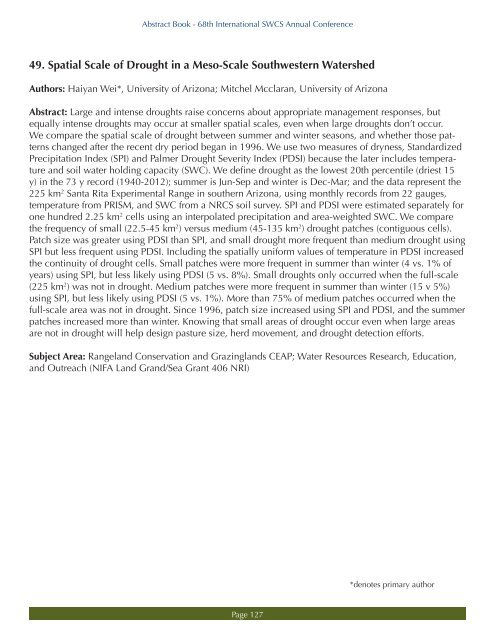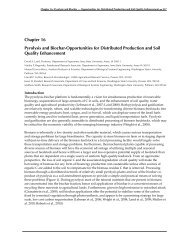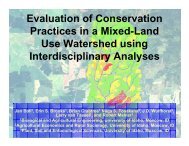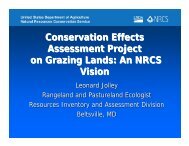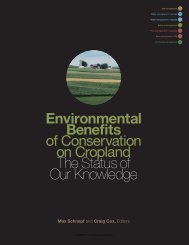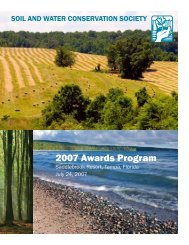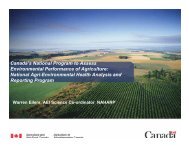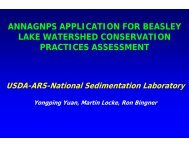Abstract Book - Soil and Water Conservation Society
Abstract Book - Soil and Water Conservation Society
Abstract Book - Soil and Water Conservation Society
You also want an ePaper? Increase the reach of your titles
YUMPU automatically turns print PDFs into web optimized ePapers that Google loves.
<strong>Abstract</strong> <strong>Book</strong> - 68th International SWCS Annual Conference<br />
49. Spatial Scale of Drought in a Meso-Scale Southwestern <strong>Water</strong>shed<br />
Authors: Haiyan Wei*, University of Arizona; Mitchel Mcclaran, University of Arizona<br />
<strong>Abstract</strong>: Large <strong>and</strong> intense droughts raise concerns about appropriate management responses, but<br />
equally intense droughts may occur at smaller spatial scales, even when large droughts don’t occur.<br />
We compare the spatial scale of drought between summer <strong>and</strong> winter seasons, <strong>and</strong> whether those patterns<br />
changed after the recent dry period began in 1996. We use two measures of dryness, St<strong>and</strong>ardized<br />
Precipitation Index (SPI) <strong>and</strong> Palmer Drought Severity Index (PDSI) because the later includes temperature<br />
<strong>and</strong> soil water holding capacity (SWC). We define drought as the lowest 20th percentile (driest 15<br />
y) in the 73 y record (1940-2012); summer is Jun-Sep <strong>and</strong> winter is Dec-Mar; <strong>and</strong> the data represent the<br />
225 km 2 Santa Rita Experimental Range in southern Arizona, using monthly records from 22 gauges,<br />
temperature from PRISM, <strong>and</strong> SWC from a NRCS soil survey. SPI <strong>and</strong> PDSI were estimated separately for<br />
one hundred 2.25 km 2 cells using an interpolated precipitation <strong>and</strong> area-weighted SWC. We compare<br />
the frequency of small (22.5-45 km 2 ) versus medium (45-135 km 2 ) drought patches (contiguous cells).<br />
Patch size was greater using PDSI than SPI, <strong>and</strong> small drought more frequent than medium drought using<br />
SPI but less frequent using PDSI. Including the spatially uniform values of temperature in PDSI increased<br />
the continuity of drought cells. Small patches were more frequent in summer than winter (4 vs. 1% of<br />
years) using SPI, but less likely using PDSI (5 vs. 8%). Small droughts only occurred when the full-scale<br />
(225 km 2 ) was not in drought. Medium patches were more frequent in summer than winter (15 v 5%)<br />
using SPI, but less likely using PDSI (5 vs. 1%). More than 75% of medium patches occurred when the<br />
full-scale area was not in drought. Since 1996, patch size increased using SPI <strong>and</strong> PDSI, <strong>and</strong> the summer<br />
patches increased more than winter. Knowing that small areas of drought occur even when large areas<br />
are not in drought will help design pasture size, herd movement, <strong>and</strong> drought detection efforts.<br />
Subject Area: Rangel<strong>and</strong> <strong>Conservation</strong> <strong>and</strong> Grazingl<strong>and</strong>s CEAP; <strong>Water</strong> Resources Research, Education,<br />
<strong>and</strong> Outreach (NIFA L<strong>and</strong> Gr<strong>and</strong>/Sea Grant 406 NRI)<br />
*denotes primary author<br />
Page 127


